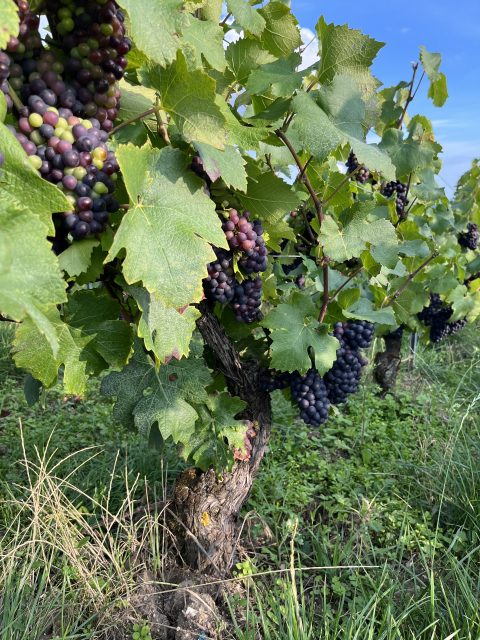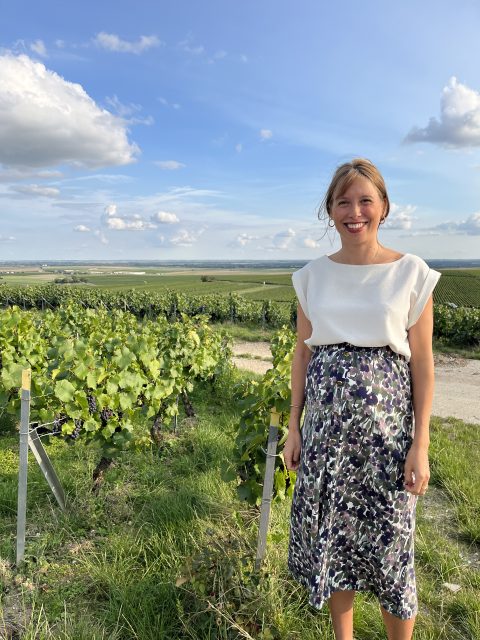Incomparable vintage in Champagne features heaviest bunches on record
By Patrick SchmittAhead of harvesting, which is due to start next week, winemakers are talking about an incomparable vintage in Champagne with the heaviest bunches ever recorded.

It was during a visit to Champagne on Tuesday this week that I noticed something different about the vineyards as I sped passed them in a car from Reims to Louvois on my way to visit Champagne Laurent-Perrier.
Wherever one looked, one could see vast bunches of grapes on the vines, each plant supporting a great mass of bulbous berries, which were deeply-coloured in the case of the Pinot Noir in the Montagne de Reims sub region (pictured above).
On arrival at Laurent-Perrier, my sense that the vintage looked bountiful was confirmed by Lucie Pereyre de Nonancourt, who represents the fourth generation at the Champagne house and looks after its prestige cuvée Grand Siècle.
“The bunches are heavy, and way above the usual weight,” she said, adding, “There are more berries on each bunch, and they are full of juice – the yields are high this year.”
Later on that day, during a discussion with Maximilien Bernardeau, who has been cellar master at Laurent-Perrier since July – although he joined the house in January – it became clear that the weight of the bunches this year are higher than ever before.
“We have the heaviest grapes ever in Champagne – the weight is more than 220 grams per bunch,” he said, remarking that the Comité Champagne record “every parameter” of the vintage, so he could be sure that a new record was being set concerning the weight of the grapes.
In a subsequent conversation with Bollinger cellar master Denis Bunner, it became apparent that the 2023 vintage in Champagne is truly remarkable.
“We are recording average bunch weights of around 240g,” he told db yesterday, before saying, “when the maximum in Champagne should be 180g,” noting that the bunches this year are more than 30% above the average.
“It’s a record,” he confirmed, commenting that already the bunches are weightier than they were in a high-yielding vintage such as 2004.
Similarly, Champagne Gosset cellar master Odilon de Varine told db on Thursday this week that it is “an incredible year,” stating, “this is the first time we have had such big grapes.”
He continued, “The bunches are more than 200g even on the Pinot Meunier, which is just amazing.”
The reason for such a profusion of big berries is primarily due to the recent wet weather in Champagne, following a good fruit set in the spring – it was warm and dry in May and June.
“We have had no hydric stress this year, and a good blossoming,” recorded Bunner, explaining why Champagne is seeing a profusion of large berries.
Such a phenomenon is recent, and unexpected, he also explained.
Notably, when the yields for the region were set by the Comité Champagne in July, it was not envisaged that the vines would produce such a big crop.
“The yields are higher than expected in July, when we expected to have small grapes; all the models were wrong this year,” said Bunner.
This is because the wet weather – which has led to a swelling of the berries – began on 1 August.
He also reminded db that the high-yielding harvest this year follows a bumper crop in 2022, even though conditions last year were completely different – it was an extremely dry vintage, while 2023 has been unusually wet.
“The trend [in Champagne] over the last 20 years was to have a decrease in the number of bunches per stalk and a decrease in weight, but that has not been the case in the last two years,” he said, adding, “Work is under way to understand this phenomenon, but at the moment, we don’t have a real explanation, just hypotheses.”

But what about the quality of the grapes this year?
Lucie Pereyre de Nonancourt picked out a few key elements to the vintage, mentioning a couple of notable aspects to 2023 in Champagne.
The first is some disease pressure, particularly on Pinot Meunier in the Marne Valley – which is colder and wetter than the Montagne de Reims and Côte des Blancs.
Commenting on the presence of botrytis on the yet-to-fully-ripen Meunier, she said, “It is a bit of challenge, because there is some disease, and it is taking a lot of time to mature.”
As for the second observation, this concerns the other two main grapes of Champagne: Pinot Noir and Chardonnay.
Partner Content
“The Chardonnay grapes are more mature than Pinot Noir – and Meunier,” she said, adding that as a result, it is expected that the harvest will begin in the places where Chardonnay grapes dominate, which are the Côte des Blancs and the Côte de Sézanne.
Bernardeau expects to start picking the grapes for Laurent-Perrier next week, telling db that he wants to bring in the bunches quickly.
Although next week is expected to be warm and dry in Champagne, with cool nights, and therefore ideal for a gradual, even ripening, Bernardeau wants to avoid the risk of harvesting disease-infected berries, while he also wants to secure grapes with a crisp acidity, in line with Laurent-Perrier’s fresh style of Champagne.
Noting on Tuesday that potential alcohol levels on Chardonnay in the Côte des Blancs are 8.5%, he said that would be picking at 9 or 9.5%, preferring to harvest at that sugar level as opposed to 10-10.5% with the threat of disease.
He also said, “We want the citrus side – so we want to be one of the first to harvest, and we want to harvest fast.”
Continuing he said, “We see others who want to wait longer for phenolic ripeness, but if the grapes are too mature then you can lose the acidity and freshness, and the wines won’t age well.”
Comparing this year with other recent, cool and wet vintages, he said that results could be excellent for Laurent-Perrier. “In 2021 and ’17, the Chardonnay in the Côte des Blancs was stunning, and very good for us, but the reputation of those vintages is poor.”
In contrast, the much-celebrated harvest of last year, which was an unusually hot and dry year, “was not so good for Laurent-Perrier,” according to the new cellar master.
“For the style of Laurent-Perrier, this year will be a good one and a better year than [the riper, more opulent] 2022,” he said, before commenting, “But we need the ’22 to balance the ’21.”
In terms of the expected nature of this year’s vintage, Bernardeau told db that he thought it would be “between 2008 and 2014 in quality”.
The official start dates for this year’s harvest (which are different depending on the location in Champagne’s 34,000 hectares of vineyards), will be announced tomorrow, with Tuesday 5 September expected to be the earliest allowed.
Bunner told db that it was unlikely that Bollinger would be starting so soon. “We are going to wait. And while we thought that if the sanitary conditions of the grapes were to decline we might begin picking on Monday, the rot has not spread, and we are confident we can reach a good maturity and make a good vintage,” he commented, noting that at the moment, “the grapes are still far away from obtaining 10% alcohol.”
Continuing, he said that the soonest Bollinger would start harvesting would be Thursday 7 September for its most early-ripening plot – the old, ungrafted grand cru Pinot Noir vineyard in Ay that is used to make Vielles Vignes Françaises.
Meanwhile, Gosset’s Odilon de Varine told db that “the earliest we will start will be Thursday, but the real beginning will be next Saturday.”
He also said, “To be honest, the botrytis is really well contained: there is only about 10% of the grapes where we find it; for the moment, only one berry in a bunch is infected.”
Adding that he is not unduly concerned about dilution due to the large berries this year, he said, “Usually, when the yield is high, we have the best quality – it is not the case in Champagne that a low yield gives the best quality, so my fingers are crossed for the quality this year.”
Commenting more generally on this year’s conditions, Bunner said, “The vintage cannot be compared to any other, it has completely different characteristics, especially [with regards] the size of the grapes.”
Adding that the Chardonnay has matured faster than the Pinot Noir grapes, when in recent vintages the opposite has been true, while recording that veraison has been unusually rapid, he expressed his surprise at the growing season.
“We are all a bit disturbed by this harvest,” he concluded.
Read more
Champagne yields to drop in 2023 as sales decline
Champagne agrees big yield increase for 2022 harvest as sales continue to surge
A decade in Champagne: rating every vintage 2011-2021
A decade in Champagne: rating every vintage 2000-2010
Related news
The 'family spirit' behind Champagne Gardet's 130th anniversary




